Update (Dec. 21, 2021): In a recent development, the government of Punjab has allowed electric buses to run on the roads of three major cities of the province, including Lahore, Faisalabad, and Bahawalpur. To combat the rising menace of smog, which is mainly caused due to the rapidly increasing air pollution, an environmentally friendly bus service will be introduced in these cities.
The decision for the approval and introduction of the electric bus service in the aforementioned cities of Punjab was taken at a Punjab Mass Transit Authority meeting held in the provincial capital. It was presided by the Chief Minister of Punjab Usman Buzdar.
UPDATE (Jan.26, 2021): Provincial Minister for Transport Jehanzeb Khan Khichi has revealed that the provincial government is planning to introduce an environment-friendly transport system in Lahore. This project will be completed in phases. During the first phase, around 50 electric buses in Lahore will be assigned to different routes. Fares will also be accepted with the help of technology. Charging stations will also be established to charge the buses.
Want to learn more about electric buses in Pakistan? Check out our piece on electric buses in Islamabad.
Besides being Pakistan’s second-most populated city, Lahore is also the capital of Punjab, with an average population of 11 million, as per the findings of the 2017 Census of Pakistan. Over the years, similar to other necessary utilities, the Government of Punjab has initiated many public transport projects in Lahore to facilitate residents of the city. Several rapid transit projects have been completed to reduce commute time and make public transport in Lahore accessible for all, while quite a few projects are underway that will connect the entire city and further empower convenient commuting.
Modes of Public Transport Available in Lahore
The major modes of public transport in Lahore include:
- Rickshaws and Taxis
- Bus Services
- Metro Trains
Rickshaws and Taxis
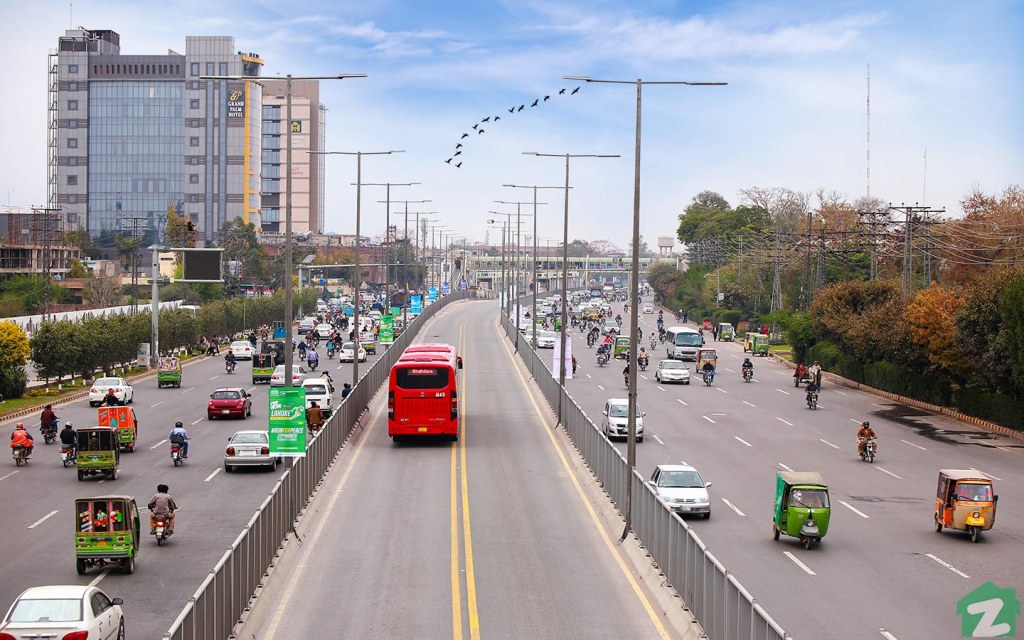
Many private ride-hailing apps are offering their services in Lahore. Meanwhile, rickshaws remain the other primary mode of transport. They are widely available, and most of them have been using CNG as their primary source of fuel since the start of the new millennia.
Bus Services
While autos or rickshaws are ideal for travelling over short distances occasionally, people in Lahore usually opt for the centrally operated bus services for their daily commute to work. There are two major providers of bus services in Lahore:
- Punjab Masstransit Authority (PMA)
- Lahore Transport Company (LTC)
Lahore Metrobus by PMA
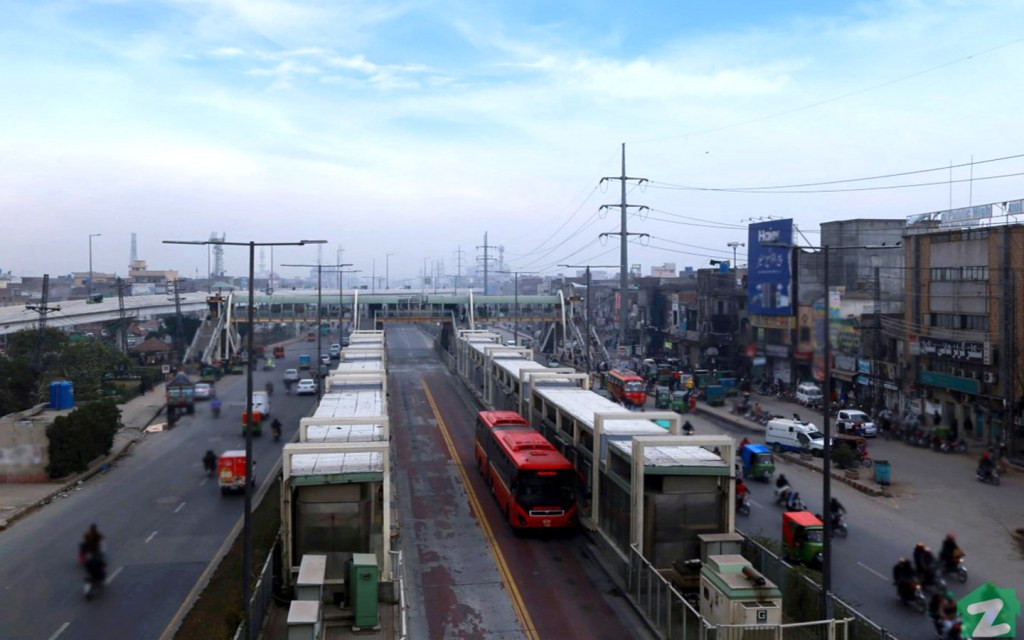
The Punjab Masstransit Authority is a regulatory body set up by the Government of Punjab to plan, construct, operate, and maintain mass transit systems in the major cities of Punjab. As such, PMA runs the entire Lahore Metrobus Service (MBS) along with all of its connecting feeder buses. Lahore Metrobus Service has become the primary mode of transport now for many locals after it became operational in February 2013. It is the first Bus Rapid Transit (BRT) system of its kind in Pakistan and has borrowed some features from Istanbul’s Metrobus system. Also, the transit system was developed with the collaboration of Turkish experts. A similar project, known as Green Line BRT, is also under construction in Karachi.
Central Metrobus Route
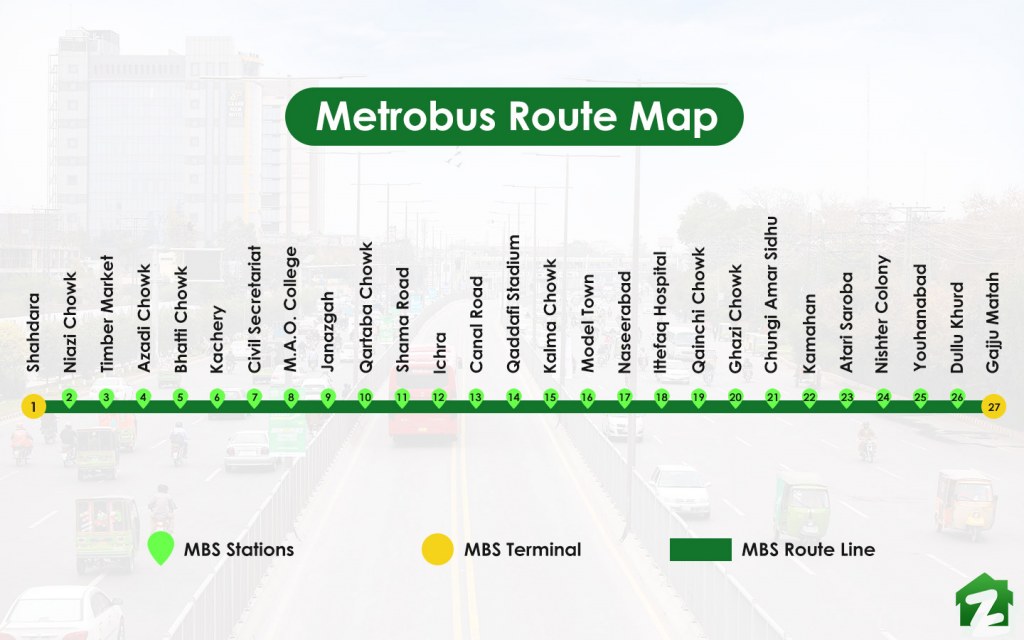
[Route Info Sourced From PMA Website]
The route of the Lahore Metrobus is serviced by more than 60 buses, each of which is 18 metres long. These buses run between 27 stations along a corridor of 27 kilometres. However, nine of these stations have been built on an overhead bridge. The central line runs from Gajju Matah to Shahdara along Lahore’s central artery, Ferozepur Road.
Feeder Bus Routes
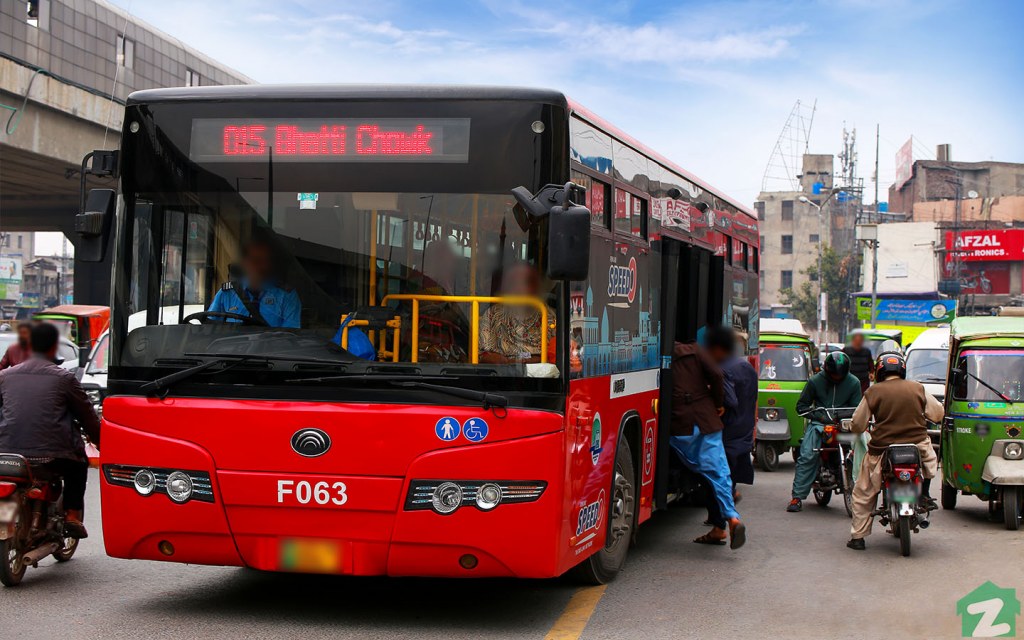
To further improve the reach of the MBS throughout Lahore, PMA runs a connecting network of feeder bus routes. The purpose behind this venture is to ensure a smooth commute for the passengers to the Metrobus System. Many of the feeder bus routes also intersect each other at some point, allowing passengers to continue their journey through town with the help of two or more bus rides conveniently. The feeder buses are air-conditioned and have 28 seats, with around 10 seats reserved for women at the front of the bus.
The feeder bus routes in Lahore are as follows:
| Route No. | Route |
| FR-1 | Railway Station to Bhatti Chowk |
| FR-2 | Bhatti Chowk to Samanabad Morr |
| FR-3 | Railway Station to Rana Town |
| FR-4 | R.A. Bazar to Chungi Amar Sidhu |
| FR-5 | Shadbagh Underpass to Bhatti Chowk |
| FR-6 | Babu Sabu to Raj Garh Chowk |
| FR-7 | Bagrian to Chungi Amar Sidhu |
| FR-8 | Canal Road to Daewoo Terminal |
| FR-9 | Railway Station to Sham Nagar |
| FR-10 | Multan Chungi to Qartaba Chowk |
| FR-11 | Babu Sabu to Gulberg Main Market |
| FR-12 | R.A. Bazar to Civil Secretariat |
| FR-13 | Bagrian to Kalma Chowk |
| FR-14 | R.A. Bazar to Purana Kahna |
| FR-15 | R.A. Bazar to Bhatti Chowk |
| FR-16 | Canal Road to Thokar Niaz Baig |
| FR-17 | Gajju Matah to PKLI |
Operating Hours
The operating hours of the Lahore Metrobus System are as follows:
Central Line Operating Hours:
6:15 am – 10:00 pm
Central Line Train Intervals:
2.25 Minutes to 3 Minutes
Operating Hours for Feeder Buses:
6:00 am – 11:00 pm
Train Intervals for Feeder Buses (Monday to Saturday):
Peak Hours (7:00 am to 6:00 pm): 5 to 10 Minutes
Off-Peak Hours (6:00 am to 7:00 pm, 6:00 pm to 11:00 pm): 10 to 15 Minutes
Train Intervals for Feeder Buses (Sunday):
10 to 15 Minutes
Ticketing Methods
While the service was declared free to use for its first month, there are two ticketing systems in place now. Both of these ticket types are available for both adults and children. The two modes of ticketing are:
Single Ride Tokens
These tokens are only valid for a single, one-way journey. They cost Rs. 20 and can either be bought at the on-site ticket booth at the station or from any of the self-service Ticket Vending Machines (TVM) available. Once you buy the token, you must tap it on the entry point of the platform to gain entry, and the token must be retained, as you will need to deposit it at the exit point to leave the platform.
Metrobus Cards
If you travel through Lahore frequently, the most convenient option is to get a Metrobus card for a safety deposit of around Rs. 130. This amount will be returned to you if you wish to give the card back to the transit authority at any time. The only condition is that the card should be in perfect working order. Once you have the card in hand, you can charge it for a value of Rs. 1,000 max to use for your travels. You can recharge the card at any TVM or a ticket booth if your balance gets used up. These credit card-sized cards make it extremely convenient to travel on the Lahore Metrobus, as you do not have to stand in line to buy a ticket for every journey.
Fare Policies
If you are purchasing a one-way ticket at a ticket booth, you must exit the Metrobus System in 1 hour and 15 minutes. Otherwise, additional charges will be applied.
An integrated fare policy is also in place that allows passengers to pay a one-time cost for the entirety of their trip (comprising of up to three journeys) if they are using a Metrobus card. The fare policy is:
- Single Journey: Rs. 15
- Two Journeys: Rs. 20
- Three Journeys: Rs. 25
However, each transfer must be within 30 minutes of the last one, and you must tap the card at the exit point to avail the discount.
Local Buses by LTC
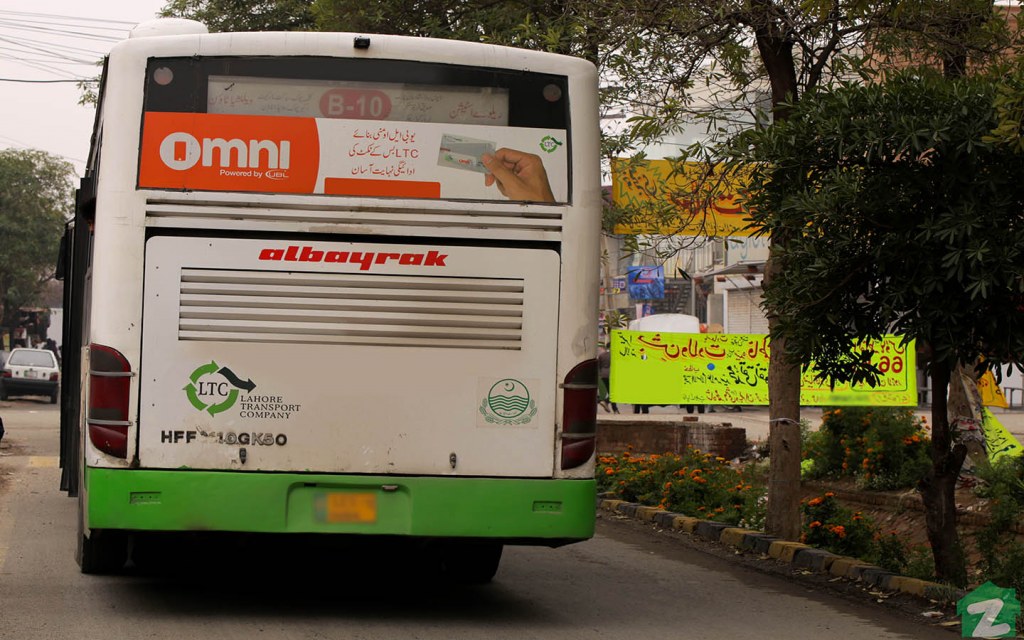
The Lahore Transport Company runs an array of High-Occupancy Vehicles (HOVs) as well as Low-Occupancy Vehicles (LOVs)/Wagons/Mini Buses on different routes throughout the city. Many of these LOVs are run by individual contractors licensed and permitted by the LTC. These local bus services interconnect with the Metrobus stations to provide a seamless transportation system within the city.
Routes
The current HOV and LOV bus routes are:
HOV Routes
| Route No. | Route |
| B-08 | General Bus Stand to Airport |
| B-10 | Valencia Town to Railway Station |
| B-12A | General Bus Stand to R.A. Bazar |
| B-19 | Niazi Chowk to Green Town |
| B-22 | Pakka Meel to LIG Terminal |
| B-33 | Bagrian Chowk to Railway Station |
LOV Routes
| Route No. | Route |
| LOV-101 | Bhati Gate to Sharaqpur Shareef |
| LOV-102 | Rang Mehal to Liaqat Chowk |
| LOV-103 | Rang Mehal to Samanabad |
| LOV-104 | Railway Station to Pakki Thatti |
| LOV-105 | Railway Station to Thokar Niaz Baig |
| LOV-105A | Railway Station to Liaqat Chowk |
| LOV-106 | Bhatti Chowk to Workshop U-Turn |
| LOV-107 | Bhati Gate to Manga Mandi |
| LOV-108 | Railway Station to Packages Gate |
| LOV-110 | R.A. Bazar to Guru Kay Aasal |
| LOV-111 | Railway Station to Bhogiwal |
| LOV-112 | Kot Lakhpat Jail to Manga Mandi |
| LOV-113 | R.A. Bazar to Jamman Shareef |
| LOV-116 | Gawala Colony to Thokar Niaz Baig |
| LOV-122 | Railway Station to Nonarian Chowk |
| LOV-125 | Phattak to Thokar Niaz Baig |
| LOV-126 | Railway Station to Attari Mor |
| LOV-128 | Bhati Gate to China Scheme |
| LOV-130 | Kahna Nau to Saddar Chowk |
| LOV-131 | Bangali Chowk to Shaukat Khanum Hospital |
| LOV-132 | Bhatti Chowk to Multan Chungi |
| LOV-140 | Railway Station to Sharaqpur Shareef |
| LOV-141 | Thokar Niaz Baig to Railway Station |
| LOV-143 | Aashiana-e-Quaid to Hair Pind |
| LOV-145 | Chungi Amar Sidhu to Chung |
| LOV-148 | Bangali Bagh to Multan Chungi |
| LOV-149 | Niazi Chowk to Salamatpura |
| LOV-152 | GBS to Padhana |
Fare Policy
The LTC does not have a fixed cost per trip. The amount you will be charged depends on the route you wish to take and the number of stops you wish to travel.
Ticketing
The LTC issues a separate Green Card for students so that they can travel at a discounted rate and a Free Bus Card is also available for all elderly citizens. Routes and fare tables can also be found on its app in the Google Play Store.
Metro Trains
The Lahore Metro, also known as Lahore Rapid Mass Transit System (LRMTS), is currently under construction within the city. It initially consisted of four lines, Green Line, Orange Line, Blue Line, and Purple Line. However, plans to build this system were converted into the more cost-effective Lahore Metrobus System, which covers the proposed Green Line. The Orange Line has also been officially inaugurated on 25th October 2020 and has become Pakistan’s first metro train service.
Orange Line
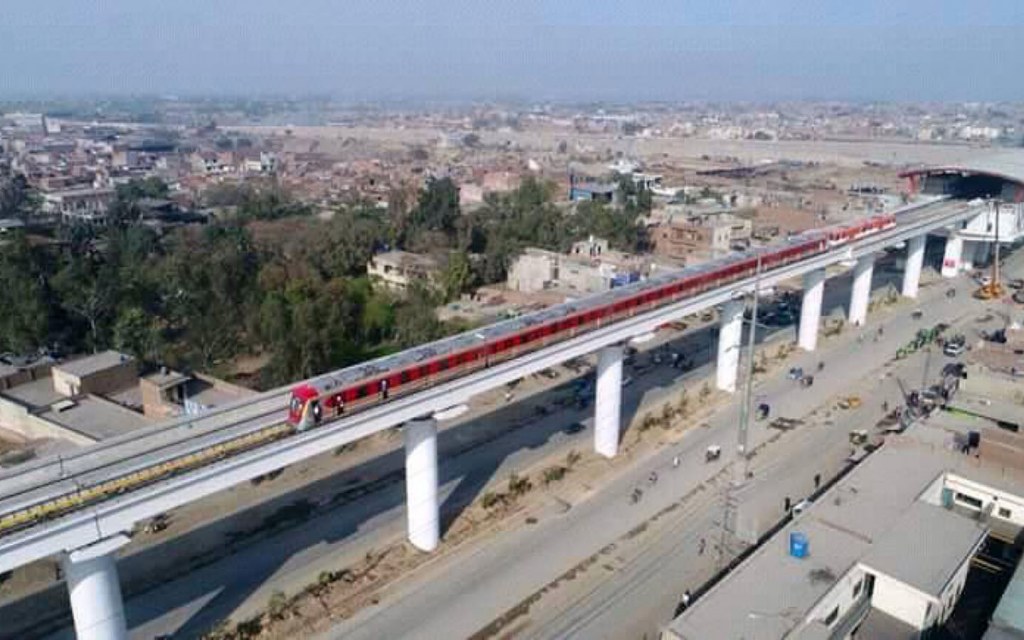
[Credits: Facebook/Orange Line Metro Train Lahore]
Spanning over a distance of 27 kilometres, with parts of it elevated as well as underground, the Orange Line of the Lahore Metro covers 26 stations and is expected to offer a quick commute to around 250,000 passengers daily.
Route

Running from North to South with a depot at the northern end and a stabling yard at the southern end, here are the stations that the Orange Line Metro will pass through daily:
- Dera Gujran
- Salamatpura
- Islam Park
- Mehmood Booti
- Pakistan Mint
- Shalimar Gardens
- Baghbanpura
- University of Engineering (UET)
- Sultan Pura
- Railway Station
- Lakshmi Chowk
- GPO
- Lake Road
- Chauburji Chowk
- Gulshan-e-Ravi
- Samanabad
- Bund Road
- Salah-ud-Din Road
- Shahnoor Studios
- Sabzazar
- Awan Town
- Wahdat Road
- Hanjarwal
- Canal View
- Thokar Niaz Baig
- Ali Town Lahore
Operating Hours
As per the plans, the Orange line will be operational for 18 hours daily, between 7:30 am to 8:30 pm.
Fare
A one-way trip on the Orange Line will cost PKR 40.
Blue Line
It is a proposed route for the Lahore Metro, spanning over 24 kilometres from Chauburji Chowk to College Road.
Purple Line
This is one of the other proposed routes for the Lahore Metro, becoming an airport to rail link over a distance of 32 kilometres.
This wraps us all there is to know about public transport in Lahore. With upcoming projects making the commute easier in the city, residents will be able to make quick trips across town at affordable rates.
Stay tuned to Zameen Blog, Pakistan’s best lifestyle blog for information regarding public transport in other major cities.



